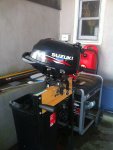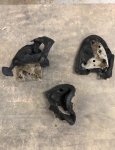Great forum and especially helpful for Boaters like my self. We have a 1999 Bryant with a 5.0 Mercruiser carb with about 650 hours.
I will try to explain the events leading up to our engine problems. Engine has been maintained through out its life by a reputable boat mechanic. Did oil change this season and current oil level is fine. Have used the boat almost every weekend this summer with no issues.
Today we put the boat in, engine started as usual with very little effort and was running great. No high temps and oil pressure was fine. We took off out of the no wake section and was still running great. Stayed around cruising speeds and was doing just fine. Went under a bridge and then took off again...still fine. As we picked up speed one of our passengers lost their hat. I circled back to grab the hat. As I pulled by it they were not able to reach it. Boat was in neutral and lake was not busy so I decided to hop in to grab the hat.
Good news is I saved the hat. Bad news is while I was swimming back I asked the wife to shut off the boat. She turned the key off but the engine still tried to keep running. (It has done this a couple times before over the last few years and I have always just turned the key back on to give it some fuel and then try shutting down again. It’s always done fine). Today however my wife just turned it off, engine tried to keep running and she didn’t know so left the key off. It eventually bogged down and shut off.
I climbed aboard, turned on the blower and turned the key. NOTHING! Almost like the motor was seized. I thought for a second that maybe it was in gear so I wiggled the shifter to ensure it was in neutral and tried it again. It turned over maybe a half a turn and sounded like it was straining pretty hard to turn over. At this point I popped open the hatch, looked for anything obvious, check oil level and for any leaks. Everything looked fine, nothing out of the ordinary. Turned it over again and it turned over but I heard a thump almost like a rod or something.
I then decided that I was done and feared I would cause more damage if I continued trying. We got a tow back to the ramp and I pulled her home.
Any idea what could have happened? I’ve read about hydro locking and how important it would be do get water out of cylinders if present. What would your first steps be other than getting it to a mechanic? I will Monday but am now scared if it does have water in cylinders and I let it sit it could be bad news. Thanks for you help.
I will try to explain the events leading up to our engine problems. Engine has been maintained through out its life by a reputable boat mechanic. Did oil change this season and current oil level is fine. Have used the boat almost every weekend this summer with no issues.
Today we put the boat in, engine started as usual with very little effort and was running great. No high temps and oil pressure was fine. We took off out of the no wake section and was still running great. Stayed around cruising speeds and was doing just fine. Went under a bridge and then took off again...still fine. As we picked up speed one of our passengers lost their hat. I circled back to grab the hat. As I pulled by it they were not able to reach it. Boat was in neutral and lake was not busy so I decided to hop in to grab the hat.
Good news is I saved the hat. Bad news is while I was swimming back I asked the wife to shut off the boat. She turned the key off but the engine still tried to keep running. (It has done this a couple times before over the last few years and I have always just turned the key back on to give it some fuel and then try shutting down again. It’s always done fine). Today however my wife just turned it off, engine tried to keep running and she didn’t know so left the key off. It eventually bogged down and shut off.
I climbed aboard, turned on the blower and turned the key. NOTHING! Almost like the motor was seized. I thought for a second that maybe it was in gear so I wiggled the shifter to ensure it was in neutral and tried it again. It turned over maybe a half a turn and sounded like it was straining pretty hard to turn over. At this point I popped open the hatch, looked for anything obvious, check oil level and for any leaks. Everything looked fine, nothing out of the ordinary. Turned it over again and it turned over but I heard a thump almost like a rod or something.
I then decided that I was done and feared I would cause more damage if I continued trying. We got a tow back to the ramp and I pulled her home.
Any idea what could have happened? I’ve read about hydro locking and how important it would be do get water out of cylinders if present. What would your first steps be other than getting it to a mechanic? I will Monday but am now scared if it does have water in cylinders and I let it sit it could be bad news. Thanks for you help.
Last edited:






















